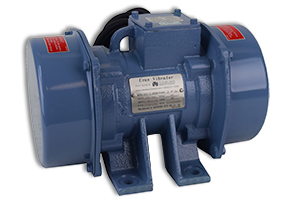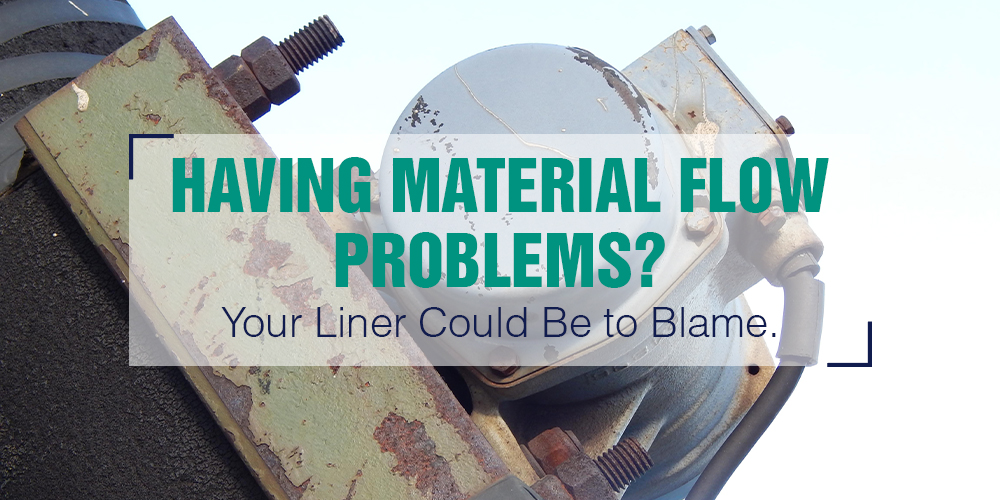Material flow problems are time-consuming, messy, expensive, and can even contribute to workplace hazards. The tricky part? Many problems can slow down your production processes, such as applying the wrong vibration force and frequency for the application, issues with the installation of the vibratory flow aid, and even the size and style of the liner applied to the inside of your bin, hopper, chute, or pipe.
That was the case with a customer who wanted to apply vibration to their ¼” thick wall chutes for sand processing. Previously, they manually cleaned their chutes with a garden hoe leading to unnecessary employee injuries, equipment damage, and production downtime. Knowing they have liners installed, we asked three important questions:
- What style of liner are they using in their chutes?
- How thick is the liner?
3. Is the liner bolted into the chutes?
These questions may seem simple, but they can play a major role when determining which industrial vibrator is best for the job. When a liner is added to the equation, our goal is to find a vibratory solution that will flex the bin or hopper wall, chute, or pipe enough to move the material. The style, thickness, and installation of the liner will affect how much vibration is needed to flex the wall of a bin, hopper, chute, or pipe.
Urethane or UHMW Liners
When working with Urethane or UHMW liners, the higher the durometer, which is the international standard for the hardness measurement of rubber, plastic, and other non-metallic materials, the more efficient the transfer of vibration will be. The lower the durometer, the more vibration will be absorbed and not transferred to the material in the hopper.
Abrasion Resistant (AR) Liners
Abrasion Resistant Liners are steel which means they are heavier and can be a big factor in the type of vibrator recommended. This could require more vibration force to move the material on the inside of the liner and equipment wall. In these situations, the installation of the liner will come into play.
Bolted vs. Welded Liners
If the liner in question is bolted in, they are not fully considered when selecting the best vibratory flow aid. This is because the vibration transfers to the equipment directly through the bolts. Ideally, for these cases, the vibrator should be positioned as close to the bolts as possible to efficiently transfer the vibration from the equipment wall to the liner and material.
For example, let’s take a 1/4″ wall and 1/4″ bolted in liner. In this case, we will size the vibrator(s) based on the 1/4″ wall. Now, if you take that same example and the liners are plug welded in, we will size for a 1/2″ wall thickness. The reason being, after plug welding those liners, it is now “solid”, whereas when they are bolted in, there is some flex between the wall and the liner.

Now, let’s revisit the questions we asked the customer who wanted to apply vibration to their sand processing chutes. After determining they have 7/8” bolted-in ceramic liners, we recommended our 4-Pole RE 12-4 Uras Techno Rotary Electric Vibrators to provide additional force due to the type and thickness of the installed liners.
As previously mentioned, since the liners are bolted in and not plug welded, we would normally use the ¼” wall of their chutes to size the vibrator. This would typically land us at a small(er) 3600 RPM vibrator. However, as we learned more about the issues this customer was experiencing, characteristics of the material they were processing, and where they saw many of their issues, this wasn’t going to be that simple.
We knew the material wasn’t completely dry, so we decided 1800 RPM was necessary as it provides more stroke than 3600 RPM. This additional stroke flexes the wall more which helps break the material free from the wall and allows it to flow freely. Now that we knew 1800 RPM was needed, we needed to know how much force was required. We knew the liners were not plug welded in, but we also knew calculating on ¼” wall alone wasn’t going to cut it.
We ultimately landed on using our calculations based on a blend of plug welded liners and bolted-in liners to land on the KEE-12-4. These units are typically used on ½” to ¾” wall depending on how much material is in the bin, hopper, chute, or pipe. Our experience told us that sizing for just the chute wall thickness was not going to work, but it also told us that sizing based on 1” plus wall was going to cause damage to the customers chute causing expensive down time.
As you can see, there are many factors to consider when applying vibration to your application. That’s why our team has made it easy with our selection guide. With many options to choose from, we have narrowed it down to help you determine how many vibrators to install and where to install them, what vibration strength is needed to get the job done, what type of vibrator is best for your application, and more.
If you’re ready to find a solution for your material flow problem, our vibration experts are here to help. Request a quote today!

Joining The Cleveland Vibrator Company team as Sales Lead in January of 2017, Steve Chinn offers extensive knowledge and experience in the Bulk Material Handling industry. As a Cleveland State University graduate with a major in Communication and a minor in Marketing, Steve works closely with Uras Techno, the manufacturer of the high-quality Rotary Electric Motor product line exclusively distributed by The Cleveland Vibrator Company.
When not *almost* losing in our company Fantasy Football league, you can find this Cleveland sports fan golfing or spending time with his wife and two kids. He even coaches his kid’s baseball teams!
Share this blog post:
Follow us:


